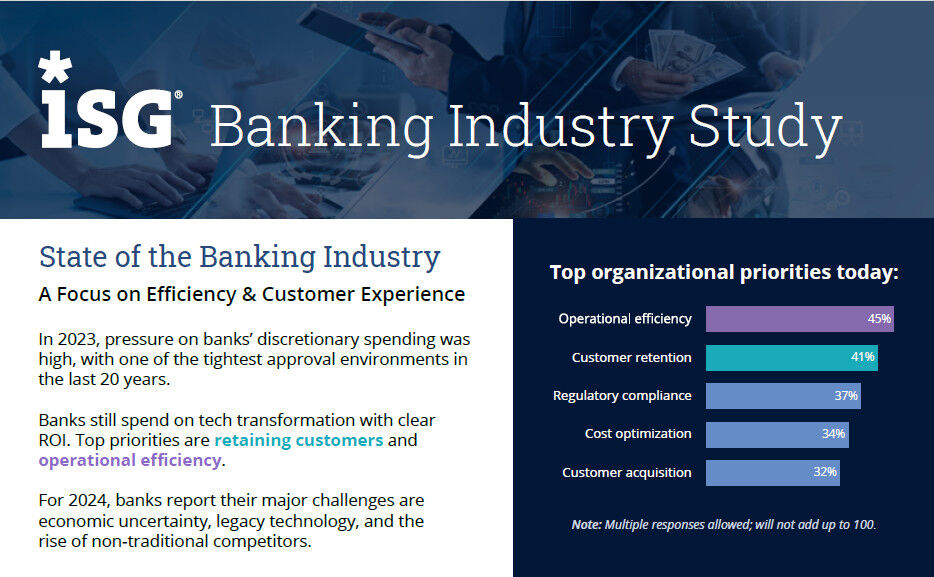Reinventing Bank Branches of the Future
While digital banking dominates, customers still value in-person services for complex financial needs. What’s the future of bank branches?
Industries



Let us help you find and implement the right technologies to improve your customer experience, optimize data and transform your business model.

ISG's recent study shows the banking industry's top priorities are operational efficiency and customer experience.
Will most people go back to purely in-person banking? No. But the demise of bank branches is greatly exaggerated - a recent Celent report says that 77% of customers want to be face-to-face for substantive discussions about their finances.
Read ISG’s whitepaper to learn how to reimagine your #branchstrategy for the future of banking.
ISG is a leader in proprietary research, advisory consulting and executive event services focused on market trends and disruptive technologies.
Get the insight and guidance you need to accelerate growth and create more value.
Learn MoreThere's a saying among military historians that amateurs debate strategy while professionals talk about logistics. In a similar vein, those rooted deeply in the workings of information technology (IT) pay close attention to data because it is fundamental to the proficiency and effectiveness of any IT system. Visionaries speak of data being the oil or gold of the information economy; practitioners recognize that it is the structural steel. Potentially, one of the unexpected benefits of the artificial intelligence (AI) revolution may be the ability and willingness to address the decades-long problems of data quality and availability. More powerful data management tools and the motivation to invest in and use them are likely to significantly reduce (but by no means eliminate) these issues. This, as much as the power of AI—in all its forms—to streamline and even automate business process execution, will lead to a step-function increase in the productivity of the Office of Finance.
The Finance and Accounting Outsourcing (FAO) market in 2025 is undergoing one of the most significant shifts it has seen in the past decade. In contrast to 2024, when discussions surrounding AI, generative AI (GenAI) and advanced analytics primarily focused on pilots and early-stage PoCs, the current landscape is defined by operationalized innovation. Providers have transitioned from experimentation to deployment, embedding these technologies into live delivery environments and demonstrating measurable business impact.
The six costliest words in managing a finance department are, “We’ve always done it this way.” The record-to-report (R2R) cycle describes the process of finalizing and summarizing the financial activities of a business for a specific accounting period—typically a month, quarter or fiscal year. It is important to note that R2R exclusively covers the activities between recording (keeping the books) and reporting (publishing financial statements and management accounts). It involves completing various tasks to ensure that all revenue, expense and other financial transactions are properly recorded, accounts are balanced and accurate financial statements can be prepared.
Doing more with less is the defining characteristic of finance and accounting departments in midsize enterprises, which ISG research defines as organizations with between 100 and 999 workers. One frustrating truth confronting executives in these organizations is that, once their company stops being a small business, it has many of the same challenges that large enterprises face but with fewer resources to deal with them. Over the past two decades, advances in information technology have had the greatest incremental impact on midsize enterprises, approaching the ability of large organizations to harness practical, affordable and reliable technology to gain productivity and improve performance, especially in the office of finance. The introduction of artificial intelligence and generative AI will close the gap further.
Every expectation of the contact center got slammed by the pandemic– from staffing, security, infrastructure, training, shoring locations, providers/captives, channels, performance to workforce management. ISG’s Sandra Williams discusses how banking contact centers became prime examples of Darwin’s theory that only the one most responsive to change will survive.